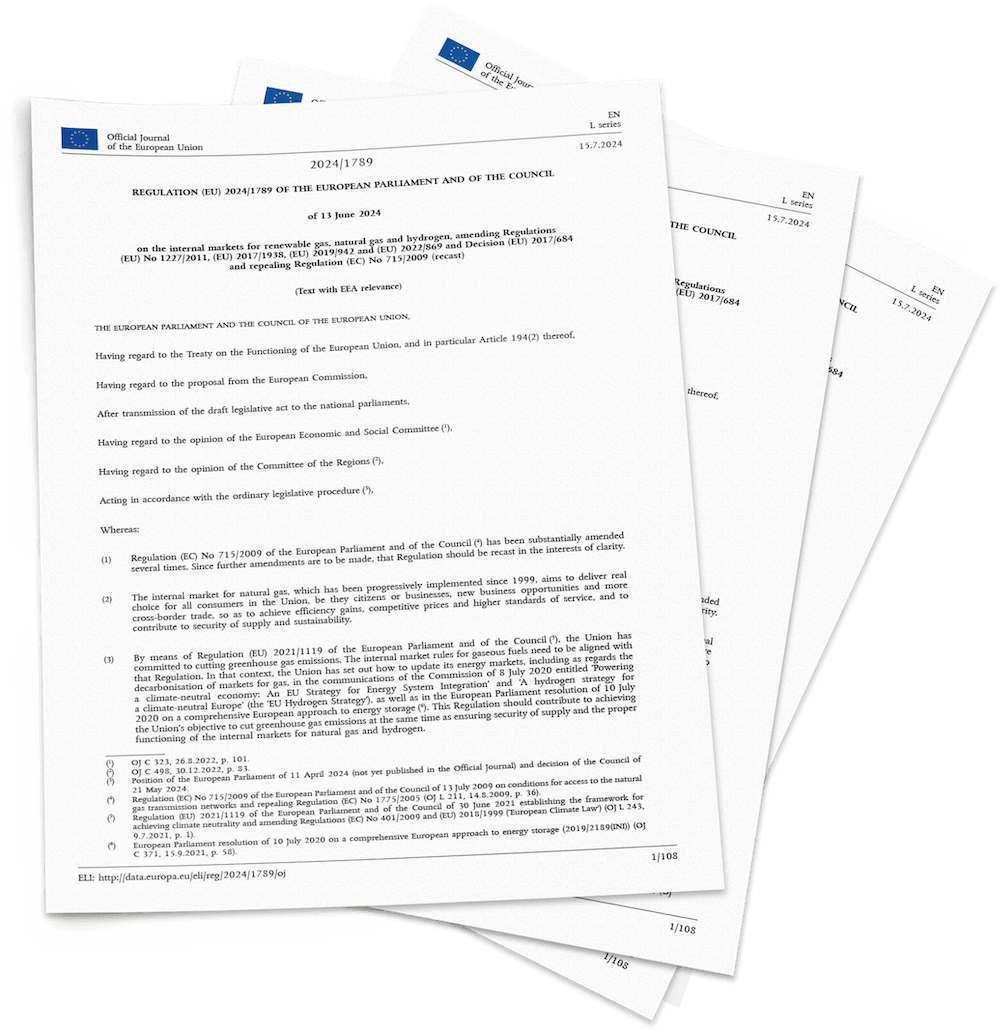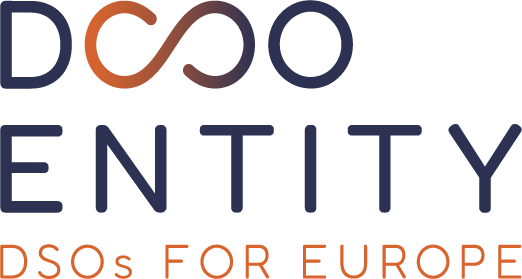Enlarging DSO Entity with integration of gas/hydrogen DSOs
Adopted by the Council in June 2024, but launched already in December 2021, the European Commission proposed the revision of the gas/H2 market regulation integrating gas DSOs into the existing structure. The cooperation of gas DSOs through’s DSO Entity was proposed in Art. 36f of the regulation.

Setting up a framework
The Gas Regulation, part of the Hydrogen and Decarbonised Gas Market Package, finally adopted by the Council in May 2024 set up a framework for integrating gas and hydrogen DSOs within DSO Entity and introduced rules for hydrogen infrastructure, according to Art. 39-41.
This is highly relevant for the more than 1100 DSOs in the EU that distribute gas to more than 80 million customers on a daily basis. Part of these are dual grid companies that already are a member of DSO Entity in their electricity grid operations.
The gas/hydrogen integration will strengthen the visibility of DSO Entity at EU level to the benefit of all DSOs. Thanks to the existing structure of DSO Entity’s organization, and the close process of consultation with the existing gas associations, accomplishing the challenging integration will be possible.
This integration will then result in an enlarged membership with newly originated tasks, while in parallel securing the current priorities of DSO Entity.
Creating a structure
Even before the adoption of the Gas Regulation, DSO Entity’s Board started discussing and approved the project structure to prepare the integration of gas and hydrogen DSOs. A temporary working structure was established to guide the integration and this included defining clear rules of engagement, the setting up of joint Task Forces, a joint Sounding Committee and the creation of a timeline. Stakeholder engagement was prioritized to ensure fair representation for both electricity and gas members, fostering balanced decision-making.
The structure relied on four key Task Forces working on:
Updating governance statutes and rules
Establishing budget/memberfee and financing mechanisms
Developing communication strategies to invite and onboard new members
Preparing for the operational launch and future implementation
The Sounding Committee (bringing together DSO Entity Board members with high level gas DSO representatives) and a Program Coordinator were established to ensure continuous dialogue and alignment with regulatory requirements, including stakeholder collaboration.
How is gas being integrated?
Drafting phase
The Statutes are being drafted and will be submitted to ACER and to the European Commission for their review and feedback. Drafting efforts include updating statutes, proposing rules for fair and balanced representation, and creating operational budgets. By involving experts and stakeholder representatives, the process aims to balance compliance with efficiency.
Final stage
Final and formal decision-making will run through the usual procedures at the level of DSO Entity’s Board and General Assembly. This includes securing approvals from the European Commission and ACER, incorporating feedback, and finalizing member onboarding procedures.
Launch
The official integration is anticipated for Q4/2025 and operational launch is foreseen in Q1/2026. By this point, the integrated DSO Entity will include both electricity and gas members, with a strong governance structure for representation and decision making, clear roles, an extended team at the Secretariat and a unified approach to addressing Europe’s energy transition challenges.
Timeline of
gas integration
EU Hydrogen Strategy
The strategy aims to scale up hydrogen production and establish hydrogen as a core energy carrier by 2050. It seeks to decarbonise sectors like industry and transport, support the clean energy transition, and foster economic growth through the development of a sustainable hydrogen value chain. This involves scaling up renewable hydrogen production, reducing reliance on fossil-based hydrogen, and creating an integrated energy system that promotes innovation and cross-sector collaboration.
Source : Key actions of the EU Hydrogen Strategy and eur-lex – A hydrogen strategy for a climate-neutral Europe
Regulation on the internal markets for renewable and natural gases and for hydrogen
The European Commission proposed to integrate the gas DSOs into the existing structure and revised the Third Energy Package as part of the Green Deal.
The regulation aims to decarbonize the EU gas sector to achieve climate neutrality by 2050 by promoting renewable and low-carbon gases, such as hydrogen, biogas, and synthetic methane. It includes market design reforms to remove regulatory barriers, enhance competitiveness, and increase flexibility in the energy system, thereby reducing reliance on fossil fuels and supporting sectors like industry and transport that are difficult to electrify.
REPowerEU Plan
In response to the energy crisis and dependence on Russian gas, this plan aimed to diversify gas supplies, boost biomethane production to 35 billion cubic meters annually by 2030, and accelerate hydrogen deployment with 10 million tons of domestic renewable hydrogen production and 10 million tons of imports by 2030.
Source : eur-lex – REPowerEU Plan, Key documents: REPowerEU and REPowerEU Affordable, secure and sustainable energy for Europe.
Proposal on EU’s Electricity Market Design Reform (EMD)
The Commission presented the proposals on the reform of the EU’s electricity market design as a response to the high and volatile energy prices in 2022. The reform package included the electricity market design regulation together with a proposal for a regulation to protect against market manipulation in the wholesale energy market, which was formally adopted by the Council on 18 March 2024. The law also aims to increase market transparency through a liquified natural gas (LNG) price assessment and benchmark.
Source : Wholesale energy markets: Council adopts law to protect against market manipulation
Electricity Market Design Reform (EMD)
Adopted by the Council on 21 May 2024. The new electricity market design rules consist of the amending Directive EU/2024/1711 and the amending Regulation EU/2024/1747.
Hydrogen and Decarbonised Gas Market Package
Adopted under the Fit for 55 Package, it sets up a framework for integrating gas and hydrogen DSOs within DSO Entity and introduces rules for hydrogen infrastructure, according to Art. 39-41 of the Gas Regulation.
Revised gas market rules
Published in the EU Official Journal and entered into force 20 days later. It updates the rules on the EU natural gas market set out in the Gas Directive 2009/73/EC and the Gas Regulation 715/2009. This legislation aims to decarbonise gas markets, promote hydrogen and biomethane integration in the gas infrastructure and reduce methane emissions. It also introduces a new regulatory framework for dedicated hydrogen infrastructure.
Source : Hydrogen and decarbonised gas market and euro-lex – Directive (EU) 2024/1788 of the European Parliament and of the Council of 13 June 2024 on common rules for the internal markets for renewable gas, natural gas and hydrogen, amending Directive (EU) 2023/1791 and repealing Directive 2009/73/EC
Establishing of the European Network of Network Operators for Hydrogen (ENNOH)

ENNOH’s main mission will be to promote the development and proper functioning of the internal market for hydrogen and the cross-border trade. ENNOH will develop Network Codes and technical recommendations of multiple topics for efficient and effective market and system operation. The establishment of ENNOH is outlined in Regulation (EU) 2024/1789, which is the part of the EU’s Hydrogen and Decarbonised Gas Market Package.
Transposition into national law
EU countries have until mid-2026 to transpose the new rules on the EU natural gas market set out in the Gas Directive 2009/73/EC and the Gas Regulation 715/2009 into their national law. When transposed, they will support the adoption of renewable and low-carbon gases, such as hydrogen, while ensuring energy security and affordability for all EU citizens.
Source : Hydrogen and decarbonised gas market

